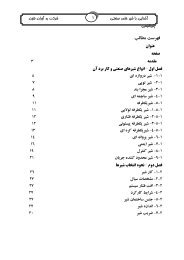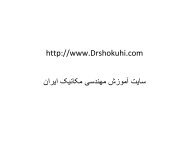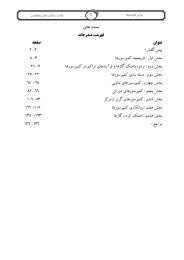Review Problems
Review Problems
Review Problems
Create successful ePaper yourself
Turn your PDF publications into a flip-book with our unique Google optimized e-Paper software.
http://www.Drshokuhi.comسایت آموزش مهندسی مکانیک
Chapter 12 Radiation Heat TransferSpecial Topic: Heat Transfer from the Human Body12-74C Yes, roughly one-third of the metabolic heat generated by a person who is resting or doing lightwork is dissipated to the environment by convection, one-third by evaporation, and the remaining one-thirdby radiation.12-75C Sensible heat is the energy associated with a temperature change. The sensible heat loss from ahuman body increases as (a) the skin temperature increases, (b) the environment temperature decreases,and (c) the air motion (and thus the convection heat transfer coefficient) increases.12-76C Latent heat is the energy released as water vapor condenses on cold surfaces, or the energyabsorbed from a warm surface as liquid water evaporates. The latent heat loss from a human bodyincreases as (a) the skin wettedness increases and (b) the relative humidity of the environment decreases.The rate of evaporation from the body is related to the rate of latent heat loss by Qlatent mvapor h fg whereh fg is the latent heat of vaporization of water at the skin temperature.12-77C The insulating effect of clothing is expressed in the unit clo with 1 clo = 0.155 m 2 .C/W = 0.880ft 2 .F.h/Btu. Clothing serves as insulation, and thus reduces heat loss from the body by convection,radiation, and evaporation by serving as a resistance against heat flow and vapor flow. Clothing decreasesheat gain from the sun by serving as a radiation shield.12-78C (a) Heat is lost through the skin by convection, radiation, and evaporation. (b) The body loses bothsensible heat by convection and latent heat by evaporation from the lungs, but there is no heat transfer inthe lungs by radiation.12-79C The operative temperature T operative is the average of the mean radiant and ambient temperaturesweighed by their respective convection and radiation heat transfer coefficients, and is expressed asToperativehconv Tambient h Th hconvradrad surrTambient T2When the convection and radiation heat transfer coefficients are equal to each other, the operativetemperature becomes the arithmetic average of the ambient and surrounding surface temperatures.surr12-60
hChapter 12 Radiation Heat Transfer12-80 The convection heat transfer coefficient for a clothed person while walking in still air at a velocityof 0.5 to 2 m/s is given by h = 8.6V 0.53 where V is in m/s and h is in W/m 2 .C. The convection coefficientsin that range vary from 5.96 W/m 2 .C at 0.5 m/s to 12.4 W/m 2 .C at 2 m/s. Therefore, at low velocities, theradiation and convection heat transfer coefficients are comparable in magnitude. But at high velocities, theconvection coefficient is much larger than the radiation heat transfer coefficient.Velocity,m/s0.500.751.001.251.501.752.00h = 8.6V 0.53W/m 2 .C5.967.388.609.6810.6611.5712.4013.012.011.010.09.08.07.06.05.00.4 0.6 0.8 1.0 1.2V1.4 1.6 1.8 2.012-61
Chapter 12 Radiation Heat Transfer12-81 A man wearing summer clothes feels comfortable in a room at 22C. The room temperature atwhich this man would feel thermally comfortable when unclothed is to be determined.Assumptions 1 Steady conditions exist. 2 The latent heat loss from the person remains the same. 3 The heattransfer coefficients remain the same. 4 The air in the room is still (there are no winds or running fans). 5The surface areas of the clothed and unclothed person are the same.Analysis At low air velocities, the convection heat transfer coefficientfor a standing man is given in Table 12-3 to be 4.0 W/m 2 .C. Theradiation heat transfer coefficient at typical indoor conditions is 4.7W/m 2 .C. Therefore, the heat transfer coefficient for a standing personfor combined convection and radiation isT room = 20°CT skin = 33°C2h h h 4. 0 4. 7 8.7 W / m . Ccombined conv radThe thermal resistance of the clothing is given to be2 2R cloth 0. 7 0. 7 0155 . clo m . C / W = 0.109 m . C / WNoting that the surface area of an average man is 1.8 m 2 , the sensibleheat loss from this person when clothed is determined to beQsensible, clothedAs( TRclothskinT1hambientcombined2) (1.8 m )(3320) C210.109m . C/W +28.7W/m . CFrom heat transfer point of view, taking the clothes off is equivalentto removing the clothing insulation or setting R cloth = 0. The heattransfer in this case can be expressed asQsensible,unclothedAs( TskinhT1combinedambient) (1.8 m )(33T122ambient8.7 W/m . C) CTo maintain thermal comfort after taking the clothes off, the skintemperature of the person and the rate of heat transfer from him mustremain the same. Then setting the equation above equal to 104 WgivesT ambient 26.4C 104WT roomClothedpersonT skin = 33°CUnclothedpersonTherefore, the air temperature needs to be raised from 22 to 26.4C to ensure that the person will feelcomfortable in the room after he takes his clothes off. Note that the effect of clothing on latent heat isassumed to be negligible in the solution above. We also assumed the surface area of the clothed andunclothed person to be the same for simplicity, and these two effects should counteract each other.12-62
Chapter 12 Radiation Heat Transfer12-82E An average person produces 0.50 lbm of moisture whiletaking a shower. The contribution of showers of a family of four tothe latent heat load of the air-conditioner per day is to be determined.Moisture0.5 lbmAssumptions All the water vapor from the shower is condensed by theair-conditioning system.Properties The latent heat of vaporization of water is given to be 1050Btu/lbm.Analysis The amount of moisture produced per day ism vapor = (Moisture produced per person)(No. of persons)= (0.5 lbm/person)(4 persons/day) = 2 lbm/dayThen the latent heat load due to showers becomesQ latent = m vapor h fg = (2 lbm/day)(1050 Btu/lbm) = 2100 Btu/day12-83 There are 100 chickens in a breeding room. The rate of total heat generation and the rate of moistureproduction in the room are to be determined.Assumptions All the moisture from the chickens is condensed by the air-conditioning system.Properties The latent heat of vaporization of water is given to be 2430 kJ/kg. The average metabolic rate ofchicken during normal activity is 10.2 W (3.78 W sensible and 6.42 W latent).Analysis The total rate of heat generation of the chickens in the breeding room isQgen,total qgen,total(No.of chickens) (10.2 W/chicken)(100chickens) = 1020 WThe latent heat generated by the chicken and the rate ofmoisture production are100 Chickens 10.2 WQgen,latent qgen,latent(No.of chickens) (6.42 W/chicken)(100chickens) = 642W= 0.642kWmmoistureQhgen,latentfg0.642kJ/s2430kJ/kg 0.000264kg/s 0.264 g/s12-63
Chapter 12 Radiation Heat Transfer12-84 Chilled air is to cool a room by removing the heat generated in a large insulated classroom by lightsand students. The required flow rate of air that needs to be supplied to the room is to be determined.Assumptions 1 The moisture produced by the bodies leave the room as vapor without any condensing, andthus the classroom has no latent heat load. 2 Heat gain through the walls and the roof is negligible.Properties The specific heat of air at room temperature is 1.00 kJ/kgC (Table A-15). The average rate ofmetabolic heat generation by a person sitting or doing light work is 115 W (70 W sensible, and 45 Wlatent).Analysis The rate of sensible heat generation by thepeople in the room and the total rate of sensible internalheat generation areQQgen,sensibletotal, sensible qgen,sensible(No.of people) (70W/person)(150 persons) = 10,500W Q Qgen,sensiblelighting 10,500 4000 14,500WThen the required mass flow rate of chilled air becomesmairQCtotal, sensiblepT14.5 kJ/s 1.45kg/s(1.0 kJ/kg C)(25 15) C15°CChilledairLights4 kW150 StudentsDiscussion The latent heat will be removed by the air-conditioning system as the moisture condensesoutside the cooling coils.25°CReturnair12-64













